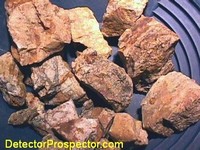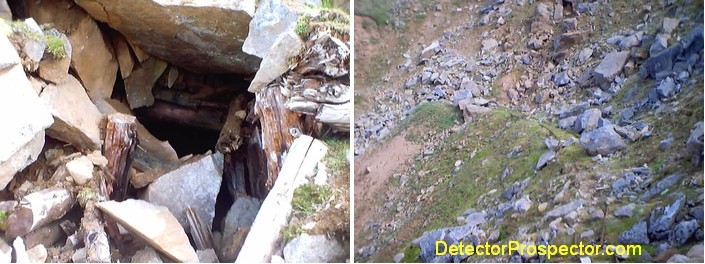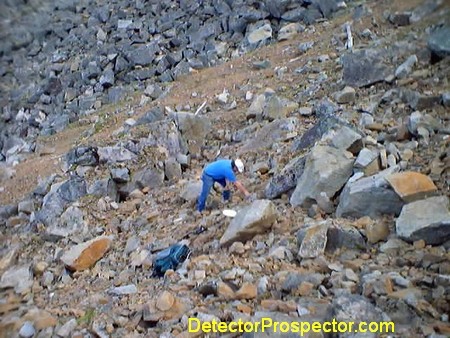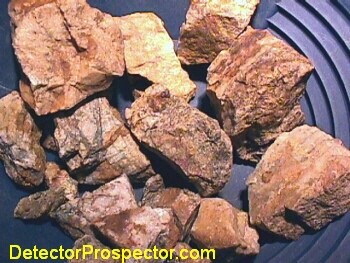
August is the month when I think about prospecting in the high country. The snow has usually melted out of the upper elevations about as far as it is going to. The days will be getting cooler by September, and by the end of September fresh snow will be falling.
I've always dreamed of finding my own vein of gold. You know, that big quartz vein with the seams of gold laced through it! I've spent almost no time actually looking for that dreamed of vein, however. Genuine prospecting takes extreme amounts of time and real dedication on the part of the prospector. It's also a real long-shot. I've known several old prospectors who spent their entire lives looking for the big strike without finding it.
So I've always concentrated on mining gold as opposed to prospecting for it. Prospecting is looking for something that has not been found yet. Mining is getting it out of the ground once it's been found. I've concentrated on known producing locations because I've always had limited amounts of time to spend.
The thought of genuine prospecting is never far from my mind, however, and I have been working towards several projects. The secret of successful prospecting is to put the odds as much in your favor as possible. Simply wandering around in the hills is a true waste of time for all but the most lucky of prospectors. Luck is great, but helping it along with knowledge is a very good idea.
First, you need a goal, one that is realistically possible. One particular interest of mine has been the application of metal detectors in prospecting for lode (hardrock) gold and other conductive metals. There is plenty of gold in Alaska, so the thought of finding it is realistic. The old timers were quite good at what they did, but Alaska is large and there remain many areas that need further prospecting. And since the old-timers did not have electronic prospecting at their disposal, new methods might reveal deposits that might otherwise have been overlooked.

Views in Hatcher Pass, Alaska (Willow Creek Mining District)
Spending time getting proficient with metal detectors and other tools of the trade is high on the list of things a person needs to do to be successful. I've been doing just that for many years, and learning about the latest technology keeps me busy. It's a bad idea to get too comfortable with a particular way of doing things when it comes to technology. Advances are constantly made that make old ways of doing things obsolete. Keeping up with the latest detectors and how they work seems like a full-time job.
Second, lots of reading. The books about detecting are important to my particular requirements, but of more general use are books about lode deposits and how they are formed. Certain rock types are associated with gold lodes, and learning what these rocks are and how to identify them is very important. Narrowing down the search by studying up on known mining districts will help the most. If you are going to look for gold or other minerals, putting yourself in a region where they have found before raises your odds tremendously. You already know the area has the right geology, so the goal is to find deposits that have been overlooked so far.
And third, the subject of this story. I believe making exploratory trips to examine known deposits to be one of the best learning tools available. Actually getting in the area of new or old mines, looking at the ground, and looking at the deposits themselves really helps translate all the book knowledge into reality. I like to look at a mine and try and figure out ''why did they decide to dig here''? It also gives me a chance to try out my detectors to find how they will work with real ore samples, and what kind of problems I might face.
I called my friend Ben and asked if he was interested in going up to Hatcher Pass north of Anchorage to detect for lode gold. He was all for it, and had an old White's Goldmaster II, so we met up and headed for the hills. The skies were overcast but the clouds were high, so it looked like weather would be no problem. And in fact, the weather improved later in the day.

Old mine portal (caved in) and rail system for dumping waste material
We hiked up to the vicinity of some old mines, keeping our eyes open for quartz. The gold at Hatcher Pass is pretty classic stuff, with slightly rusty quartz being what you are looking for. We found some small test pits, and I showed Ben my method for checking quartz samples.
I tend to cheat while scanning quartz float for gold. Float is quartz that has traveled, or ''floated'' away from the original vein. In many cases you may be dealing with sub-grain particles of gold scattered through the quartz. The ground conditions around hardrock mines are usually not the best for working the detectors at high gain/sensitivity settings.
So I run the smallest coil for the detector, then jack all the settings full up. I pick up the quartz samples and rotate them around on the bottom of the upside down coil. This takes a bit of practice with the Fisher Gold Bug 2 or White's Goldmasters as you must keep your hand away from the coil. But I've found I can extend my fingers and roll the suspect quartz around on the coil. Some of the gold enclosed is so small that if the quartz chunk is more than a couple inches thick you cannot detect it. So rotating it around to expose all sides is important.
Now the trick here is that most any nugget detector will work. But the more sensitive the unit is to small gold, the better the chances on less rich ore. From my personal use I give the Fisher Gold Bug 2 with small 6.5'' coil the nod. The Goldmasters follow-up, mainly because you are stuck with the 10'' coil. I have not tried the Sierra Hot Foot out for this use, but it may be the ticket for the Goldmaster for scanning quartz samples.
The Tesoro Lobo ST with small coil is surprisingly hot when used like this, since you can run the sensitivity up into the red zone on the dial. The 3x7 concentric is quite sensitive for a machine running at 17.5 kHz. So it might also be a detector to try for this purpose.
Like everything in gold it all depends on what you have for potential targets. For Hatcher Pass, the quartz is relatively pure with enclosed gold. There are some conductive sulphides, but they tend to be with gold also, so no problem detecting them. The gold tends to be small, although rich pieces exist. But the more sensitive the detector is to small gold, the better luck you will have. Rich ore with larger gold will be no problem for most detectors.
I recommend anyone considering this method air test their detector with 1 grain or smaller pieces of gold. If you cannot get significant depth on a 1 grain piece of gold then weaker ore will be hard to find. Air testing is valid as I am suggesting you hand manipulate the samples.
Now notice I'm not saying any model of detector will not work. I really am not a brand name guy... I'm just reporting what has worked for me. The smart thing to do is test your machine and see if it will do the job. If it works, great! Bench testing will save a lot of field time in this particular area.
A side note here. Yes, I have a Falcon Gold Probe. And yes, it is hot as can be on tiny gold. But it really only scans a 1'' wide area at best, and so is not very practical for examining volumes of rock. I use it once I get my or samples home to pinpoint the gold so precisely that I can run my little rock saw through the right spot to get good cross sections showing gold.

Ben detecting hillside below old mine
We started finding and scanning quartz as we wandered up the hill towards the old mines. I finally found some quartz that gave a signal, and saw a bit of gold in the piece. In the pack it went. More patient work revealed more pieces of ore for my backpack.
Ben seemed to be having a hard time with his detector. It appeared to have a short in the wiring somewhere. But beyond that, much of the gold I was detecting was just slightly too small for him to get a good signal with the Goldmaster. The Gold Bug 2 has a definite edge with it's small coil. This did not surprise me, as I have used the Goldmaster units for this before, and had migrated to the Gold Bug 2 to get that extra edge.
We finally got up to some old mine shafts and wandered around checking out the old portals and various remnants of the old mining operations. One thing that impressed me was the amount of rock that had rolled down off the mountain in the years since the mining took place. The upper slopes are obviously not very stable, and large rocks littered the old mining sites.
We looked in a few old tunnels, but stayed out of them. It's never a good idea to go into these old mines. The safety standards of the day were minimal, and the supports, if any, have weakened over the years. It's not worth your life to chase a few ore samples inside these old mines. We did find a few more pieces of gold bearing quartz around the old portals.
The day was getting late and so we finally decided to head back to my truck. I had a dozen good ore samples to show, and once again was very happy with my Gold Bug 2 for this kind of work. Ben also liked what he saw, and decided he would have to have one also.

Steve's gold ore samples from trip
Going down is much easier than going up, and we were back at the truck in no time. The weather had cleared considerably, and we enjoyed a nice drive back to town under sunny skis.
Please be aware that most of the hardrock mines in Hatcher Pass are patented properties. In other words, they are no longer just mining claims, but actually are private property. Few of the mines in the area are ''abandoned'' and permission should be sought from the mine owners to sample the mine dumps. Use extreme caution around the old mines, as many tunnels, shafts, and old structures present a hazard to the unwary.
See my previous story on Detecting for Lode Gold at Hatcher Pass for more information.
~ Steve Herschbach
Copyright © 2001 Herschbach Enterprises
-
 1
1






